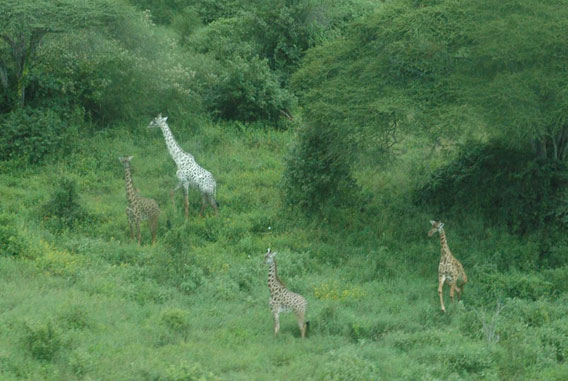“Albino” giraffe spotted by WCS in Tanzania
WCS press release
September 8, 2005

The white giraffe. Photo copyright Charles Foley/Wildlife Conservation Society.
What do an African researcher and the fictional character Captain Ahab have in common? Both were searching for a legendary white beast, and whereas Ahab searched for his white whale, Wildlife Conservation Society (WCS) researcher Charles Foley sought–and finally found–his white giraffe.
Foley first heard the tale of a white giraffe in 1993, when he began working in Tanzania’s Tarangire National Park, where he conducts long-term research on the park’s savanna elephant populations.
“Despite intensive searching, I never saw the giraffe,” recalls Foley. “And by 1994, the sightings stopped coming in, so I assumed it had died, either at the hand of man or beast. I never stopped looking though.”
Twelve years later, Foley was rewarded for his search. While conducting an aerial survey of the park’s sub-population of elephants, a distant white reflection caught his eye. “I looked…blinked…looked again… and it was still there,” said Foley.
Not content with a mere sighting, Foley told his pilot–fellow WCS researcher David Moyer–to make another pass over the spot, just over the trees. Traveling some 100 kilometers per hour, with his camera pointing out of the window, Foley captured an image of the white giraffe on film, ending a 12-year quest to find the apparition.
“The resulting photo reflects a slight juggling of the camera, yet the proof is there to see-a mostly white giraffe with small dark blotches on its body. Only the bottom half of its legs were the more traditional brown color,” he added.
On a scientific note, Foley doubts that this white giraffe is the same one that others reported seeing in 1993, and is probably not a pure albino animal, but a leucistic animal, which means the animal is lighter than normal. Nevertheless, he feels his more idealistic motive for sighting the white giraffe has now been satisfied. And unlike Ahab, he lived to tell the tale.
Wildlife Conservation Society
The Wildlife Conservation Society saves wildlife and wild lands through careful science, international conservation, education, and the management of the world’s largest system of urban wildlife parks. These activities change attitudes toward nature and help people imagine wildlife and humans living in sustainable interaction on both a local and a global scale. WCS is committed to this work because we believe it essential to the integrity of life on Earth.
For more information visit wcs.org